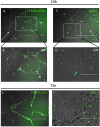The Aortic Ring Co-culture Assay: A Convenient Tool to Assess the Angiogenic Potential of Mesenchymal Stromal Cells In Vitro
- PMID: 28994816
- PMCID: PMC5752259
- DOI: 10.3791/56083
The Aortic Ring Co-culture Assay: A Convenient Tool to Assess the Angiogenic Potential of Mesenchymal Stromal Cells In Vitro
Abstract
Angiogenesis is a complex, highly regulated process responsible for providing and maintaining adequate tissue perfusion. Insufficient vasculature maintenance and pathological malformations can result in severe ischemic diseases, while overly abundant vascular development is associated with cancer and inflammatory disorders. A promising form of pro-angiogenic therapy is the use of angiogenic cell sources, which can provide regulatory factors as well as physical support for newly developing vasculature. Mesenchymal Stromal Cells (MSCs) are extensively investigated candidates for vascular regeneration due to their paracrine effects and their ability to detect and home to ischemic or inflamed tissues. In particular, first trimester human umbilical cord perivascular cells (FTM HUCPVCs) are a highly promising candidate due to their pericyte-like properties, high proliferative and multilineage potential, immune-privileged properties, and robust paracrine profile. To effectively evaluate potentially angiogenic regenerative cells, it is a requisite to test them in reliable and "translatable" pre-clinical assays. The aortic ring assay is an ex vivo angiogenesis model that allows for easy quantification of tubular endothelial structures, provides accessory supportive cells and extracellular matrix (ECM) from the host, excludes inflammatory components, and is fast and inexpensive to set up. This is advantageous when compared to in vivo models (e.g., corneal assay, Matrigel plug assay); the aortic ring assay can track the administered cells and observe intercellular interactions while avoiding xeno-immune rejection. We present a protocol for a novel application of the aortic ring assay, which includes human MSCs in co-cultures with developing rat aortic endothelial networks. This assay allows for the analysis of the MSC contribution to tube formation and development through physical pericyte-like interactions and of their potency for actively migrating to sites of angiogenesis, and for evaluating their ability to perform and mediate ECM processing. This protocol provides further information on changes in MSC phenotype and gene expression following co-culture.
Similar articles
-
Angiogenic potency evaluation of cell therapy candidates by a novel application of the in vitro aortic ring assay.Stem Cell Res Ther. 2017 Aug 14;8(1):184. doi: 10.1186/s13287-017-0631-1. Stem Cell Res Ther. 2017. PMID: 28807010 Free PMC article.
-
Glucose withdrawal induces Endothelin 1 release with significant angiogenic effect from first trimester (FTM), but not term human umbilical cord perivascular cells (HUCPVC).Angiogenesis. 2020 May;23(2):131-144. doi: 10.1007/s10456-019-09682-0. Epub 2019 Oct 1. Angiogenesis. 2020. PMID: 31576475
-
Comparing the angiogenic potency of naïve marrow stromal cells and Notch-transfected marrow stromal cells.J Transl Med. 2013 Mar 27;11:81. doi: 10.1186/1479-5876-11-81. J Transl Med. 2013. PMID: 23531336 Free PMC article.
-
Angiogenic Effects and Crosstalk of Adipose-Derived Mesenchymal Stem/Stromal Cells and Their Extracellular Vesicles with Endothelial Cells.Int J Mol Sci. 2021 Oct 8;22(19):10890. doi: 10.3390/ijms221910890. Int J Mol Sci. 2021. PMID: 34639228 Free PMC article. Review.
-
Mesenchymal Stromal Cells (MSCs): A Promising Tool for Cell-Based Angiogenic Therapy.Curr Gene Ther. 2021;21(5):382-405. doi: 10.2174/1566523221666210917114353. Curr Gene Ther. 2021. PMID: 34533444 Review.
Cited by
-
Anti-PTK7 Monoclonal Antibodies Inhibit Angiogenesis by Suppressing PTK7 Function.Cancers (Basel). 2022 Sep 14;14(18):4463. doi: 10.3390/cancers14184463. Cancers (Basel). 2022. PMID: 36139622 Free PMC article.
-
A Challenge for Engineering Biomimetic Microvascular Models: How do we Incorporate the Physiology?Front Bioeng Biotechnol. 2022 Jun 20;10:912073. doi: 10.3389/fbioe.2022.912073. eCollection 2022. Front Bioeng Biotechnol. 2022. PMID: 35795159 Free PMC article. Review.
-
The therapeutic potential of mesenchymal stem cells for cardiovascular diseases.Cell Death Dis. 2020 May 11;11(5):349. doi: 10.1038/s41419-020-2542-9. Cell Death Dis. 2020. PMID: 32393744 Free PMC article. Review.
-
Standardization to Characterize the Complexity of Vessel Network Using the Aortic Ring Model.Int J Mol Sci. 2024 Dec 31;26(1):291. doi: 10.3390/ijms26010291. Int J Mol Sci. 2024. PMID: 39796147 Free PMC article.
-
Antiangiogenic Activity and in Silico Cereblon Binding Analysis of Novel Thalidomide Analogs.Molecules. 2020 Dec 2;25(23):5683. doi: 10.3390/molecules25235683. Molecules. 2020. PMID: 33276504 Free PMC article.
References
-
- Potente M, Gerhardt H, Carmeliet P. Basic and therapeutic aspects of angiogenesis. Cell. 2011;146(6):873–887. - PubMed
-
- Hoeben A, Landuyt B, Highley MS, Wildiers H, Van Oosterom AT, De Bruijn EA. Vascular endothelial growth factor and angiogenesis. Pharmacol Rev. 2004;56(4):549–580. - PubMed
-
- Khan TA, Sellke FW, Laham RJ. Gene therapy progress and prospects: therapeutic angiogenesis for limb and myocardial ischemia. Gene Ther. 2003;10(4):285–291. - PubMed
Publication types
MeSH terms
LinkOut - more resources
Full Text Sources
Other Literature Sources







